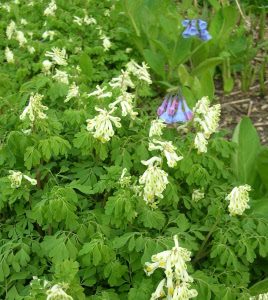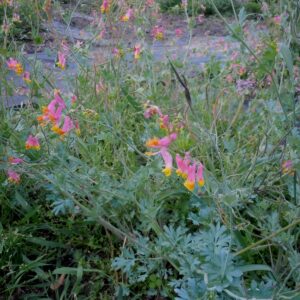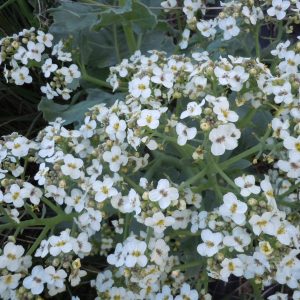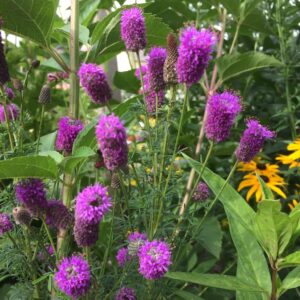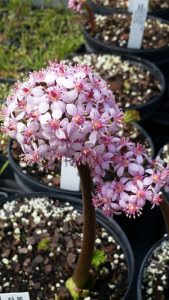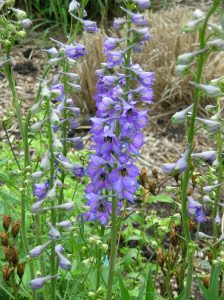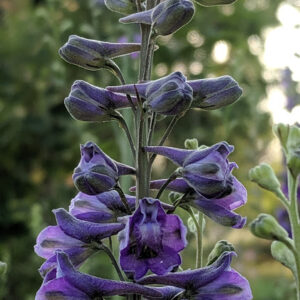Perennials & Biennials
Showing 129–136 of 511 results
-
Corydalis ochroleuca syn. Pseudofumaria alba Z 4-8
Clumps of crem white with a touch of yellow, narrow, tube-shaped flowers with flared ends bloom over mounds of ferny foliage from late spring – fall. One of longest blooming flowers for shade.
OUT OF STOCK
Clumps of cream white with a touch of yellow, narrow, tube-shaped flowers with flared ends bloom over mounds of ferny foliage from late spring – fall. One of longest blooming flowers for shade.
Size: 6-12” x 12”
Care: Shade to part shade in well-drained soil
Native: BalkansCorydalis is Greek for “lark” korydalos, referring to the shape of flower resembling a lark’s spur. This species published in 1831. Gertrude Jekyll (1848-1931) planted Corydalis ochroleuca as a “wide carpet” under peonies in her spring garden at her home, Munstead Wood.
-
Corydalis sempervirens syn. Capnoides sempervirens, Fumitory, Rock harlequin RESEEDING SHORT-LIVED PERENNIAL
Pink tube-shaped flowers with flaring yellow ends bloom from spring to summer
RESEEDING SHORT-LIVED PERENNIAL
Pink tube-shaped flowers with flaring yellow ends bloom from spring to summer
Size: 10-12” x 10-12”
Care: Sun to part shade in moist well drained soil
Native: from Nova Scotia west to Alaska, south to North Carolina, Wisconsin nativeCorydalis is Greek for “lark” korydalos, referring to the shape of flower resembling a lark’s spur. First described and named (name now changed) in 1753. Pressed specimen in Emily Dickinson’s herbarium.
-
Crambe maritima Sea kale Z. 5-9
Very sweetly fragrant, honey-scented, chalky white flowers cover the plant in late May and early June. Ornamental, bluish crinkled foliage all season.
Sweetly fragrant, honey-scented, chalky white flowers cover the plant in late May and early June. Ornamental, bluish crinkled foliage all season.
Size: 18” x 12”
Care: Moist well-drained soil in full sun
Native: Western Europe to Asia Minor
Awards: England’s Royal Horticultural Society Award of Merit and Great Plant Pick Award from Elisabeth Carey Miller Botanical Garden.Crambe means cabbage in Greek. “The glaucous leaves of the Sea kale afford a striking contrast to the bronzy foliage of surrounding subjects…I have eaten them several times and thought them delicious.” The Garden March 1876. “By the turn of the 19th century, sea kale was a very popular vegetable; its blanched shoots, which have a sweet, nutty cabbage flavor, were readily found in the finest markets and restaurants,” The American Gardener, March/April 2009. Grown by Jefferson. Recommended as an ornamental flower by Gertrude Jekyll in 1908 for its glaucous foliage.
-
Dalea aurea syn Parosela aurea Golden prairie clover Z 5-9
Cone-shaped fuzzy yellow flower spikes rise above sparse foliage in April-June
ARCHIVED
Note: This is a plant not currently for sale. This is an archive page preserved for informational use.
Cone-shaped fuzzy yellow flower spikes rise above sparse foliage in April-June
Size: 1-3’ x 1’
Care: sun in dry soil
Native: West US from TX to WY
Wildlife Value: Attracts bees, butterflies
Size: Native Americans used Golden Prairie-clover to treat diarrhea and colicCollected and described by Thomas Nuttall, 1813.
-
Dalea purpurea syn. Petalostemon purpurea Violet prairie clover Z 4-9
Vase shaped clump with wands of violet to purple encircling tall coneheads mid-summer
Vase shaped clump with wands of violet to purple encircling tall coneheads mid-summer
Size: 2’ x 18”
Care: full sun in well-drained to moist well-drained soil.
Native: Canada to Texas, Wisconsin native
Wildlife Value: Host for caterpillars of Dogface Sulphur, Striped blue & Mexican blue butterflies. Supports over 80 bee species including endangered Rusty patched Bumble BeesDalea named to honor English botanist Dr. Samuel Dale (1659- 1739.) Chippewa, Meskwaki and Navajo used medicinally – as remedies for heart ailments, pneumonia, diarrhea and measles. Comanche and Lakota chewed the root like gum, for its sweet taste. Sioux combined it with Amorpha canescens, Leadplant to ambush bison. Sioux also treated fevers and stomach disorders with an infusion made from the plant. Pawnee made brooms from the flexible stems. 1st collected by French botanist André Michaux (1746-1802) who spent 11 years in America collecting hundreds of new plants.
-
Darmera peltatum syn. Peltiphyllum peltatum Umbrella plant, Indian rhubarb Z 5-8
Grow this for its pink umbellifer flowers in earliest spring or its gigantic, round ruffled edged green turning red foliage for drama.
Grow this for its pink umbellifer flowers in earliest spring or its gigantic, round ruffled edged green turning red foliage for drama.
Size: 3-4’ x 3’
Care: shade to part sun in moist well-drained to wet soil
Native: Oregon & California
Awards: Royal Horticultural Society Award of Garden MeritKarok natives (NW corner of California) ate young shoots and Miwok tribal members, (N central California), mixed crushed root with acorn meal to make it white. Collected before 1849 when its description first published.
-
Delphinium elatum Perennial larkspur Z 2-7
Spikes of blue to purple single, elf-capped shaped blossoms with black eyes in June, repeating in August-September. Sturdy stems.
OUT OF STOCK – Email for Availability
Spikes of blue to purple single, elf-capped shaped blossoms with black eyes in June, repeating in August-September. Sturdy stems. One of internationally known garden designer Piet Oudolf’s 100 “MUST HAVE” plants, Gardens Illustrated 94 (2013)
Size: 4’ x 12”
Care: part sun in moist well-drained soil.
Native: Siberia & central EuropeGrown in the Eichstätt Garden, the garden of Johann Konrad von Gemmingen, prince bishop of Eichstätt in Bavaria, c. 1600. One of the parents of today’s border hybrids. Pressed specimen in Emily Dickinson’s herbarium.
-
Delphinium exaltatum Tall Larkspur, American larkspur Z 4-8
Fabulous, not because of a big flower-head, but because it grows everywhere with no special care, graceful lavender or purple spikes of trumpets on tall stems in July to August and beyond.
Fabulous, not because of a big flower-head, but because it grows everywhere with no special care, graceful lavender or purple spikes of trumpets on tall stems in July to August and beyond.
Size: 3-4' x 9"
Care: sun to part shade in moist well-drained soil. Withstands winds, no staking needed. Not fussy. Let the seeds drop & you’ll get babies.
Native: Pennsylvania to No. Carolina west to Ohio & Alabama
Wildlife Value: attract hummingbirdsDelphinium, named by Dioscorides, is Greek for “dolphin” due to the resemblance of the flower shape. According to William Aiton (1731-1793), early director at Kew Royal Garden, Quaker nurseryman and explorer John Bartram (1699-1777) sent it to England. London’s Chelsea Physic gardener Philip Miller grew it in 1758. Jefferson planted this at Monticello in the NW quarter of the outer border in March 1811.

